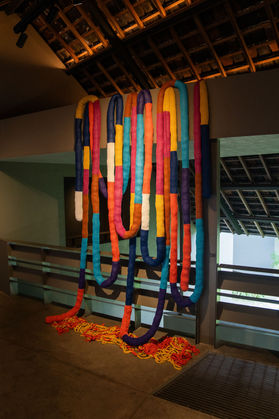The Fruit That I've Become - Solo Exhibition

The Fruit That I’ve Become
A Solo Exhibition by Yessiow
14 June – 14 July 2025
There’s a certain kind of memory that lingers in the body before it’s fully understood. For Yessiow, it started with the hum of knitting machines, the smell of fabric dye, and the repetitive rhythm of hands looping yarn into patterns. She grew up in a knitting factory in Bali, surrounded by textiles, colors, and the quiet care of her parents’ craft. They are both knitting artists. As a child, she didn’t think of their work as “art” it was simply life. But over time, she came to see it as the foundation of her own visual language.
The Fruit That I’ve Become is a deeply personal exhibition. One that marks a turning point in Yessiow’s practice. Known primarily for her large-scale murals and street art, she has spent the last decade painting in public spaces across different countries. She has always been drawn to walls, to movement, to the pulse of cities. But after years of constant travel and outward expression, she found herself needing to pause, to turn inward, to come home, not just physically, but creatively.
This exhibition became a space for that return.
At its heart, The Fruit That I’ve Become is about growth. It’s about how time, place, memory, and personal history shape who we become. Yessiow uses the metaphor of fruit because it holds everything she wanted to explore: softness, sweetness, resilience, labor, and transformation. A fruit begins as a seed. It grows slowly, weathering sun and rain. It ripens. It changes color. And one day, it falls. Ready or not.
Each piece in this exhibition carries a different layer of that process. There are paintings that speak of childhood nostalgia and of navigating cultural expectations. There are knitted works some made by Yessiow, others in collaboration with her parents that wrap those stories in warmth. These textiles are more than decorative; they are intergenerational threads. They represent the parts of her identity she didn’t always understand but has come to honor and reclaim.
Working with her parents on this exhibition has been one of the most meaningful parts of Yessiow’s journey. Through their collaboration, she found a quiet kind of healing. They didn’t need many words, Just shared time and the rhythm of their hands working side by side. Their contributions aren’t just supportive; they’re integral. The knitted textures in this exhibition are symbols of their ongoing presence in her life. Reminders that even when she’s far away, their love and prayers continue to embrace her from a distance.
The Fruit That I’ve Become is not only a body of work, it’s a story of becoming.
It’s about recognizing where Yessiow comes from and how that shapes where she goes. It’s about turning softness into strength and finding meaning in slow, quiet processes. It’s also a tribute to those who made her their care, their labor, their belief in her path. The exhibition brings together mural language, textile traditions, personal narratives, and new studio experiments. It marks the beginning of a larger body of work exploring family, craft, and emotional continuity across generations.
This story wouldn’t have come to life the way it did without the thoughtful lens of Rupa Bali, a writing and research collective led by three incredible women: Mbok Savitri, Mbok Pennawati, and Mbok Mita. Together, they listened closely to Yessiow’s journey, unpacked layers she hadn’t fully articulated, and wove their insights into the exhibition text. Through conversations, reflection, and shared cups of coffee, they helped give language to feelings that had lived wordlessly inside her for years. Their writing didn’t just document her work, it became part of it, extending the dialogue between personal history and public expression.
"I am also deeply grateful to Mbak Puti and the team at Ruang Arti Derau (RAD), who offered me the space and freedom to play, experiment, and explore. In this homey gallery space in Bali, I felt held and supported in ways that encouraged vulnerability and new possibilities. This exhibition was not just shown, it was grown. With care, with community, and with love."









